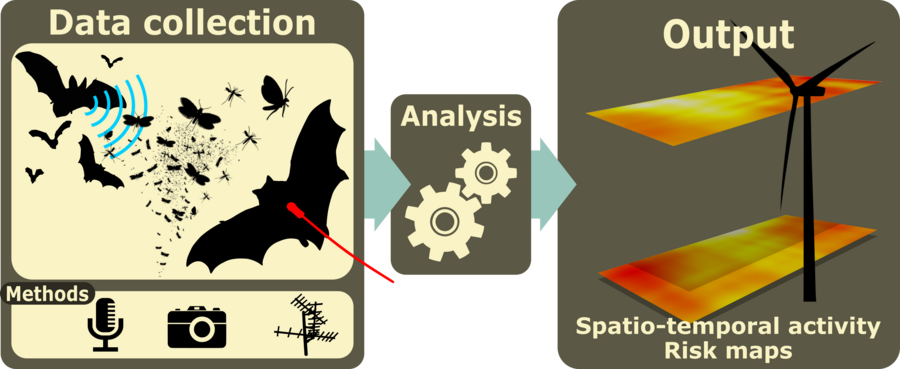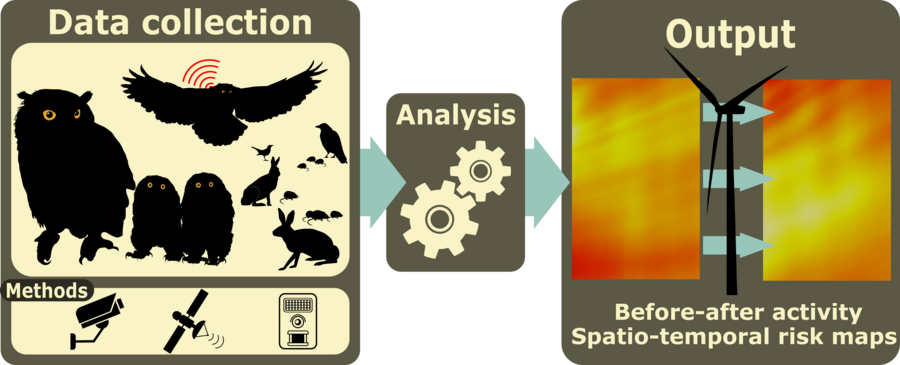About the project
Background
There is an urgent need to shift to renewable energy generation. But this transition currently poses significant risks to wildlife, and these must be addressed before renewable energy can be considered truly sustainable.
Norway is home to nearly 1400 wind turbines that account for approximately 10% of the annual energy production in the country. The Norwegian government aims to increase the wind energy production. Wind energy infrastructure may impact birds and bats directly (mortality from contact with turbines) or indirectly through avoidance of areas with turbines or habitat loss. This creates the potential for long-term, cumulative impacts on populations.
In development of wind energy in Norway, pre-construction assessments of potential impacts on birds have been carried out in many projects, whereas post-construction monitoring has been limited until recently. Impacts of wind turbines on bats in Norway are understudied. In contrast to common practice in many other countries, potential risks of adverse effects on bats are not regularly included in current environmental impact assessments or post-construction monitoring programmes.
Pre-construction assessments often have low accuracy with respect to predicting impacts on wildlife. Post-construction monitoring is necessary to evaluate the risk a given wind turbine or wind farm may have toward causing fatalities and other negative impacts. There is a need for more science-based knowledge to develop better methods for assessing and predicting impacts on wind turbines on bats and birds, which can inform evidence-based decisions on the placement, configuration, and operation of wind turbines.
Objectives
Project goals:
(1) Study the effects of wind turbines on
- spatial distribution and movements of eagle owls and bats, and
- breeding success and turnover of established eagle owl pairs
For eagle owls and bats, we shall:
(2) describe and explain relationships between activity and behaviour in time and space, and food availability, weather conditions, and the location of the wind turbines in the landscape,
(3) map expected future activity and risks near wind turbines
The project results will form the basis for evidence-based decisions on the placement, configuration and operation of wind turbines, as well as licensing and regulation.
Methods
We will use GPS/satellite tracking to study habitat use and movements of eagle owls. We will use a combination of methods, inlucing camera trapping and DNA sampling, to assess breeding sucess and turnover of established pairs, and to measure prey availability for eagle owls.
We will deploy bat boxes and build Motus receiver stations to capture, radio-tag and track the movements of migratory bats. We will also collect bat acoustic data and quantify prey (insect) abundance using camera traps and other methods.
Workflows for data collection and analyses of bat (upper) and owl (lower) data. Note that the size of the radio-tag is exaggerated to aid visualization:


Graphical illustrations: Pierre Dupont. Analyses will be carried out by NMBU’s Applied Quantitative Ecology Group (AQEG).
Species
The project will collect data on all bat species present in our study area in Rogaland. With regards to birds, the project will focus on a single species: the Eurasian eagle owl, which is the largest owl species in the World.
NRK article about the eagle owl popuation in the study area.
Birds:
- Eurasian eagle owl Bubo bubo (hubro)
Bat species confirmed or expected to be present in the study area, and known to have moderate or high collision risk:
- Common noctule Nyctalus noctula (storflaggermus)
- Nathusius pipistrelle Pipistrellus nathusiii (trollflaggermus)
- Northern bat Eptesicus nilsonii (nordflaggermus)
- Parti-coloured bat Vespertilio murinus (skimmelflaggermus)
- Soprano pipistrelle Pipistrellus pygmaeus (dvergflaggermus)

The Nathusius's pipistrelle bat (Pipistrellus nathusii) is of extra concern for being at risk at coastal and offshore wind farms. Photo: Shutterstock Partners
Research partners:
- University of Sussex (professor Fiona Mathews)
- The project Noctur team also collaborates with bat expert Jeroen van der Kooij.
Private and public sector partners:
- Ecofact AS
- Norsk Vind AS
- Norwegian Environment Agency (NEA)
- The Norwegian Water Resources and Energy Directorate (NVE)
Participants
NMBU researchers
Time line
Start
1 October 2023
